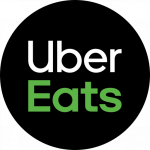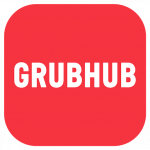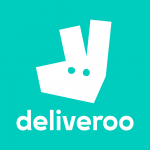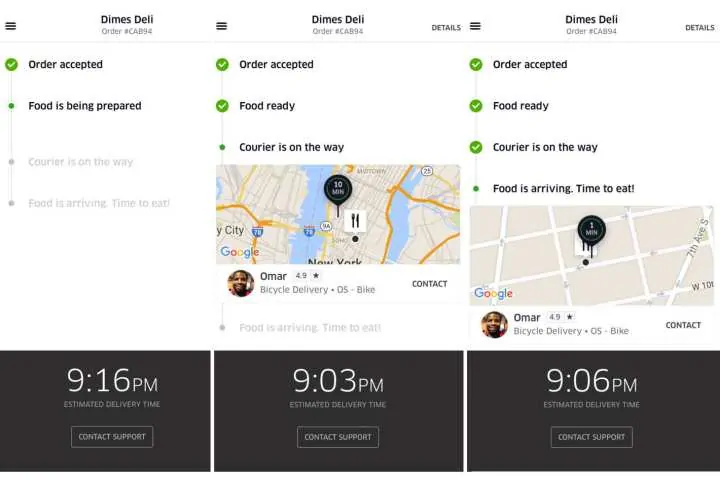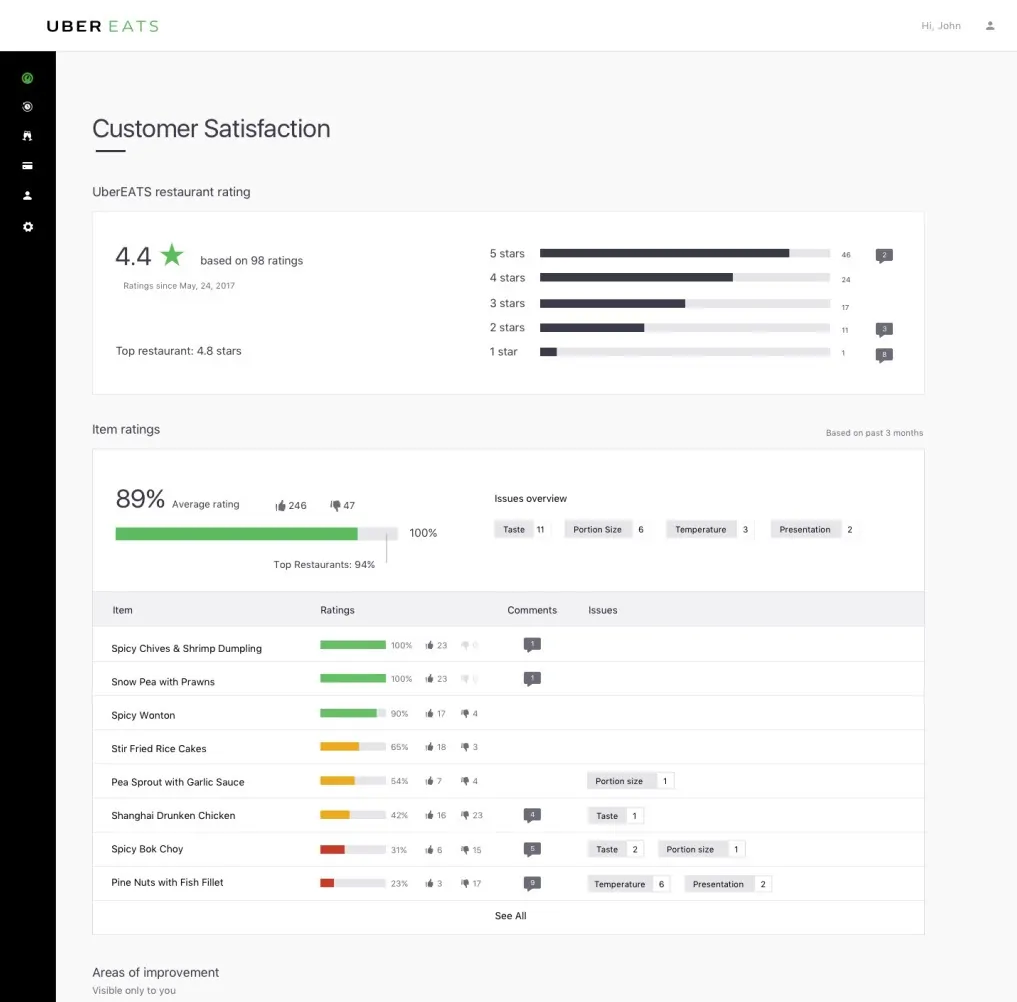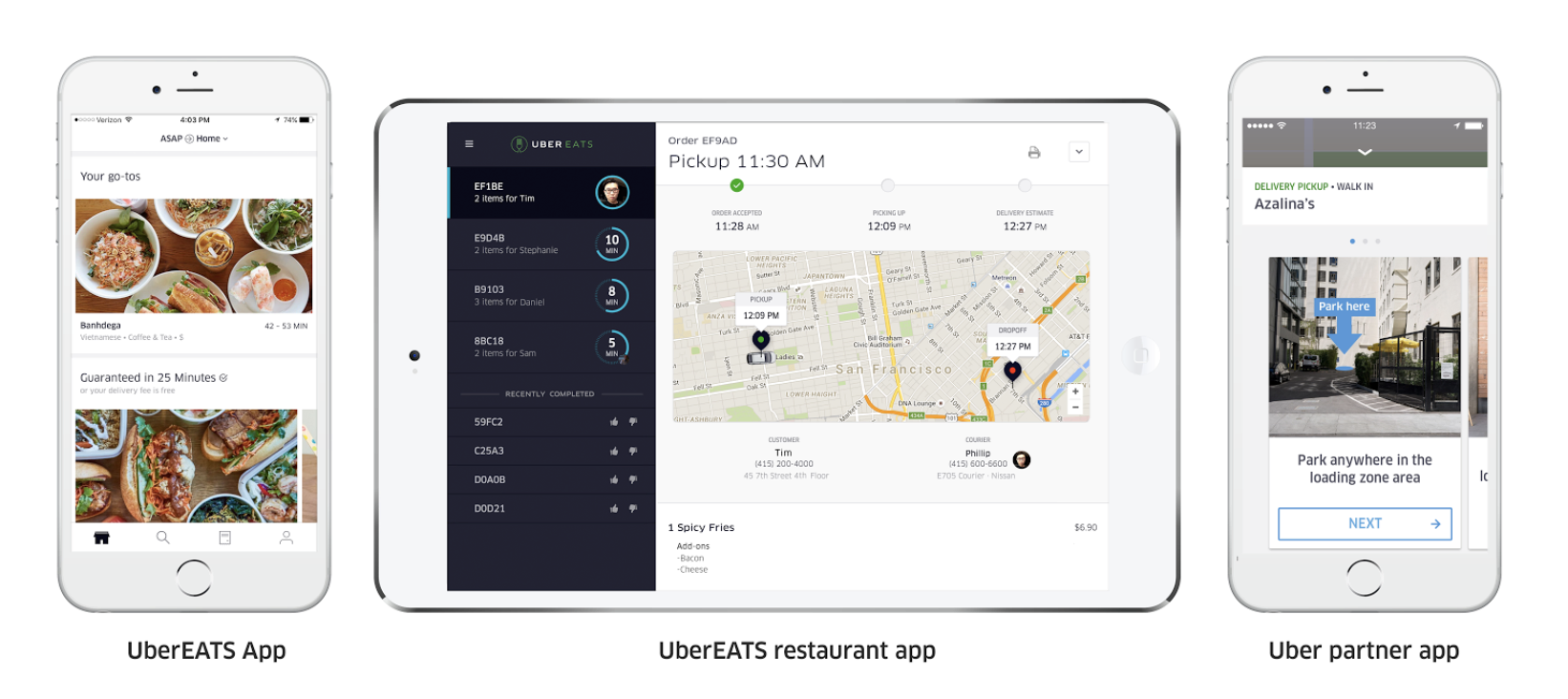
Updated: May 10, 2024
Published: August 30, 2019
Defining the users’ needs is the first thing you need to do while starting food delivery app development. We suggest learning the main market requirements for an ordering app, learning its main features, and estimating its approximate cost. In this article, we have found valuable suggestions on how to make a food delivery app and provide real value for your users.
List of contents
- Market research for defining food delivery app features
- Examples of the most successful food delivery apps
- Reasons to start food delivery app development
- Core features of a good food delivery app
- Food delivery app development cost
- Conclusion
FOOD DELIVERY APP DEVELOPMENT: MARKET STATE IN 2022
According to the online ordering statistics, customer preferences have tremendously changed over the last decade. Digital ordering and delivery services are growing 300% faster than dine-in traffic. Restaurants are looking for new solutions to keep pace with the market needs. Therefore food delivery application development has become an inevitable tool to set up in business. Customers are interested in the simplicity and accessibility of ordering services that should be provided with just one click. Fast and excellent interaction is something both sides are looking for. Restaurants are applying for the services of the aggregator apps as they establish successful communication channels for presentation and sales. Small businesses have a slight chance to develop their applications and compete against big food aggregators like Uber Eats, Grubhub, and Deliveroo. Therefore, this article will discuss how to make a food delivery app from the perspective of the food and ordering platforms. The apps allow many restaurants to offer their goods and services and collect them all in one place.
To start with, every company ready for a food delivery app development needs to search the market and outline the users’ preferences. Another important aspect is the convenience restaurants and hospitality business. After all, the food ordering application won’t be able to gain any users if there wouldn’t be a variety of offerings. Food delivery app requirements depend on the initial purposes of the project. You must provide the exceptional value and unique experience that users will stay with. Differentiating between the must-have and nice-to-have features is essential in correctly organizing the development process. The must-have features are prioritized and usually covered in the initial release, while nice-to-have features can be added gradually in the following updates.
Moreover, all features of a food delivery app should correspond to the needs of the users and market requirements. When you start food delivery app development, you should consider the most necessary features, which are login, user account, the list of goods or services, orders, payments, and push notifications. However, such functionality as AR, maps integration, camera features, and QR scanner integration could be added sequentially. The conclusion is pretty simple. The main focus should be on elements that correspond to the concept of your final product. The integration of the credit card billing to pay for services directly in the application should be delivered when you are selling goods and services for your customers. In addition, always present the innovative, attractive and easy-to-use UI and UX to withstand the competition.
EXAMPLES OF SUCCESSFUL FOOD ORDERING APPS
We will look at the top food ordering aggregators in the context of the functionality that has made them so popular. The point is that the project’s success depends on the functionality that differentiates you in the market. Thus we will have a list of the features that are a must-have for any company planning to make a food delivery app.
Uber Eats
To create a food delivery app, the taxi service came up with an innovative concept to attract restaurants and customers worldwide. UberEats has covered many nice-to-have features such as the scheduled delivery, cashless transactions, including the option to tip the courier, delivery time estimation, and tracking in real-time. As for their service fees, UberEats charges 15% of the order subtotal.
Grubhub
This application serves customers in the UK and the USA. It is known for its food variety and partnering with international chains and local restaurants. The search engines focus not only on the restaurant option but on cuisine (Chinese, Italian, European) and even the specific meal (pizza, salads, desserts). The customer can save the delivery location from shortening the order process. The application does not charge any extra fees for their customers. Only the restaurant might have order minimums and set some additional charges.
Deliveroo
If you want to learn more about food delivery app development, check another example widely used in Europe, Australia, and Asia. The success of this application is based on the local variety. They are partnering with premium restaurants that usually do not offer delivery. The highest standards’ quality is at the core of their app concept. Deliveroo has a limited ordering radius but can deliver your order for up to half an hour. The charges depend on the distance and the final delivery time.
Consequently, analyzing those platforms, we have found the comprehensive answer to how to make a food delivery app. Every takeaway mobile app has a number of must-have features, but at the same time, they are looking for a unique concept that makes them popular.
Gathering food delivery app requirements is an essential step that brings value, and it should be performed thoroughly and accurately. Requirements gathering usually happens during the discovery phase of development. Business analysts, product owners, and project managers are most involved in this process. BA holds regular meetings with the client to figure out all details about the future product. As the result, they get a software requirements specification document that explicitly describes all food delivery app functional requirements based on user stories, acceptance criteria, etc.
Want to know more about requirements gathering?
What does the SRS document contain? Who forms it? Who participates in the discovery stage, and what other stages are there? In the article, you’ll find answers to these questions, and receive a detailed explanation of the development process from the client’s point of view.
REASONS TO START FOOD DELIVERY APP DEVELOPMENT FOR YOUR BUSINESS
Developing a food delivery app is a great idea because it allows businesses to tap into the growing online food ordering and delivery market. With the convenience and flexibility that food delivery apps offer, more and more customers are turning to these services to have their meals delivered. Additionally, a food delivery app can help businesses increase revenue, reach new customers, and improve operational efficiency. There are several common reasons why a business might want to develop a food delivery app:
- Increased convenience for customers: One of the main benefits of a food delivery app is that it allows customers to order food from their phone or tablet and deliver it to their location. It’s especially convenient for customers who are unable to leave their homes, such as those who are disabled or elderly or those who are simply too busy to go out and pick up their food.
- Increased sales: An app allows customers to easily order food and can increase the number of orders a business receives. That is because customers are more likely to order food when it is convenient for them rather than calling or visiting a restaurant in person. Additionally, an app can increase the average order value by making it easy for customers to add items to their cart and view menu items.
- Improved customer engagement: A food delivery app allows easy communication between the business and the customer, such as notifications about order status and promotional offers. It can help keep customers informed and engaged with the business, ultimately leading to increased loyalty and repeat business.
- Increased efficiency: Automating the ordering and delivery process can save time and reduce business errors. That can help to improve the overall customer experience by reducing wait times and ensuring that orders are accurate. Additionally, a food delivery app can help businesses better track inventory, manage orders and deliveries, and analyze customer data.
- Cost-effective: A food delivery app can be a cost-effective way for businesses to expand their customer base and reach new audiences. It is because the cost of developing and maintaining an app could be generally much lower than the cost of opening a new physical location. Additionally, a food delivery app can also help businesses to save on marketing costs by providing a direct channel for communicating with customers.
On top of these, a food delivery app can also provide an opportunity to increase your brand awareness and increase your reach with potential customers. You can also use your app as a means of data collection and learn more about your customers, their preferences, and behaviors. It can help you to refine your menu, improve your customer service, and increase your overall profitability.
FOOD DELIVERY APP DEVELOPMENT: CORE FEATURES
Now let’s decompose three examples of successful companies and make a list of must-have features that unite all of them. When any company thinks about how to make a food delivery app, it is the first obvious thing to consider. For a successful food delivery app development like Uber Eats or any other aggregator, you should cover the needs of all the parties that take part in the food ordering chain: clients, restaurants, and couriers. So let’s make the functionality list according to the users’ roles.
Client’s Perspective
The first and the most obvious is the client’s version of the application. This is the part where most of the efforts should be. It requires a fast interface, convenient controls, and trendy design. This is the app where users perform three main actions in the chain: browse the offers, make orders, and checkout. Those who need to make a food delivery app should prioritize those features to provide an excellent user experience and achieve success.
Simple registration. The registration process is the first step to building a long-lasting relationship with your clients. They will never come back to use the application if it is too complicated, slow and confusing. Give the choice of sign-up methods. They can either create a new account using the email address or log in via Facebook or Google.
Placing an order. Such functionalities as adding, editing and removing the dishes are must-have ones. Including the order summary, where you confirm the chosen dishes, their quantity, the delivery location, etc. is necessary. The appointed time option will be appreciated by the customers as they can place an order in advance.
Various payment options. During the food ordering app development, you should consider in-app payment and cash options, so that each type of user can choose the suitable option for them. Follow all the requirements concerning security, support, and secure and fast experience. The system of bonuses and coupons should also be considered while calculating the final cost.
How do payment gateways work and how to add them to your app?
For those who want to include card payments in their food delivery app, it’s essential to know what the payment gateway is, and how it works. In the article, you’ll also find out about the core features of payment gateways, and the ways to integrate them into the Android, iOS, or hybrid applications.
Delivery time estimation. The overall success considerably depends on the provided quality and efficiency. Determining the delivery time helps manage clients’ expectations and decrease delay complaints. Customers choose not only on dishes and restaurants but also how long they are ready to wait for the order.
Order tracker. People hate waiting. Customers prefer to stay informed about their takeaway. With the help of simple notifications like approved, cooking, picked, delivering and completed, they can keep in touch and track the whole order process. However, it’s necessary not to be intrusive. One notification per ten minutes is more than enough.
Reviews and rates. When you start food delivery app development, you should think about sales as well. Reviews and rates are an excellent way to optimize client experience and your brand’s recognition. It will, consequently, lead to considerably improved sales. Make sure you encourage your customers’ reviews by asking for service feedback. It is expected for a client makes an order only after reading several reviews.
Attractive design. When you create a food delivery app, UI design has to focus on a unified look. This category of applications includes lists of services and catalogues of restaurants and meals. The designers need to work on organizing and presenting all of them according to the standardized product concept.
How to create wireframes that will lead to a successful user experience?
Designers create wireframes at the initial stages. They are the basis for further design. Successfully created wireframes mean excellent mockups and a prototype. But how to choose the best wireframing software to create a good modern design? Read to find out.
A great search engine. Customers will not waste time on seamless searching. You can include several options, including restaurant names, location, cuisines or specific meals. Excellent UX design predicts the customers’ moves in advance and is ready to maintain this experience. Make sure you design a delivery system ready to guide your client through every need.
Restaurants’ Perspective
After you’ve completed the food delivery app development for customers, it’s time to think about the restaurants. Services like Uber Eats offer two tools for restaurants. The first one is pretty simple and runs on a tablet used by the staff to get all the needed information about new orders and help them complete those orders. The second one is usually the web portal for the business manager that keeps the records to analyze the overall service performance, quality, and popularity of dishes. It is designed to add new menu items, upload photos, etc. Also, the admin panel gathers and organizes all the financial information in one place.
Registration. The developers should add this functionality for every user, including restaurants. Since you create a food delivery app for many businesses, they need to create accounts to manage the whole supply chain on their own. Protect the data of your partners by adding password change and recovery options. Naturally, the restaurant app version should have quite different registration requirements, like the physical address verification procedure, legal business information, etc. It should be more like a questionnaire than the regular registration process. Restaurant management should answer the questions about their offerings that will help the app correctly catalogue and place it among others.
Content management. Another piece of advice to take when you figure out how to make a food delivery app, cover all necessary tools for the restaurants to manage the content. Restaurants always have to add general info, including address, working hours, and menu offers. Well-organized UX design enables convenient updating: editing or deleting menu items, changing costs, uploading photos, etc.
Order management. Keep in mind that excellent management should be one of the priorities in the food delivery app development process. It begins with receiving the detailed order request and finding the appropriate ways to carry it out. In addition to the order list overview, the restaurant staff can regularly update its status, clarify some details directly with the clients if needed, and send push notifications to keep in touch with customers and couriers. Usually, this part of the service looks like a simple tablet application that sends messages and detailed information about new orders. After the charges appear on the tablet, they are manually added to the POS terminals.
Restaurant management dashboard. This is the unique portal developed for the restaurant administration where they can make changes to the menu, update the description, add new services, and manage the payment history. In short, it keeps records with the help of which it is possible to analyze rates, dish popularity, and clients’ preferences to find ways to improve your services.
Couriers’ Perspective
Food delivery app requirements for couriers are more straightforward than in the case of clients’ or restaurants’ applications. This simple companion app for couriers is very similar to the Uber Driver. It has a bare minimum of the functions and data that helps courier to do their regular job.
Registration. The food ordering aggregator platforms offer the services of their couriers or use the help of freelancers who register in the system and can start to work after the simple verification procedure. In both cases, they need to be registered and validated to make deliveries. During the registration, they must fill in all the required information in the profile like general info, ID photos, mobile number, email, etc.
Order management. This functionality enables updating all order requests. They need to have the ability to find the order description, its specifications, pickup location, the delivery time and distance to the destination. Taking into account all the mentioned details, the courier can accept or reject carrying out the particular request.
Delivery status update. Couriers must update the status at least twice when the order is picked and completed. It gives a chance for both companies and clients to be notified. It is common to keep the money in escrow until the food is delivered to the client. Thus the courier is also responsible for the closing part of the ordering process.
FOOD DELIVERY APP DEVELOPMENT COST
Covering the needs and expectations of all the users, the company needs to develop three applications:
The mobile app for clients targets your initial purpose – selling services and goods. It is the catalogue of goods developed to attract users. It should differentiate by outstanding performance, the user-friendly interface and excellent experience. Applying the up-to-date technologies is required for such functionalities as simple registration, placing the order, various payment options, delivery time estimation, order tracker, reviews and rates, attractive design and an excellent search engine. The average cost to create a food delivery app of medium complexity could be $50 000.
The mobile app and web portal for restaurants arrange the catering process and help to manage it properly. The application should not be that complicated but simple to approve the order, apply the changes if needed and deliver it to the destination. It includes registration and order management. In contrast, the restaurant’s administration is responsible for content management and the control panel, including financial questions, via the web portal. Counting these options, the company could pay up to $10 000.
The app for couriers is like the one for Uber drivers. You need to include registration, order management and the status update. It will be enough to support the requirements to carry out the order. So the company could spend $15 000 on it.
So, what’s the price of food delivery app development?
Accordingly, the estimated cost of the food delivery app development could be close to $75 000. Of course, it depends on the specific business case and client’s requirements, but we hope that the readers will be able to make the proper assumption using the list of features we’ve provided for this example as an analogy.
We hope that we have suggested some ideas on how to make your own food delivery app project and prepared some rules to remember while implementing it:
- Target your audience
- Provide the real value for your users
- Define and follow the product concept
- Look for simplicity and accessibility
- Use up-to-date technologies
- Develop both iOS and Android apps
- Add essential functionality for the first version
- Maintain good performance
- Provide attractive design
- Keep the regular updates
- Ask for feedback
- Always keep in touch with your users
IN CONCLUSION
Taking into account all the mentioned details, we can make the conclusion that the food ordering app development requires a professional workforce, time and resources. Careful planning and learning your users’ needs clarify a lot of important cornerstones. The point is that you need to target not only the clients but restaurants and couriers as well. Covering all their needs is the proven business strategy that focuses on how to make a food ordering app that can become a successful market competitor.
Are you considering building a food delivery app?
Existek can provide you with a consultation, answer your questions, and listen to your excellent ideas! We are a professional outsourcing company with extensive expertise in mobile app development that has found a lot of reasonable solutions for different projects. We are glad to share our experience with food delivery app development. Feel free to contact us, and we’ll get back to you soon.
Frequently asked questions
How much does it cost to make a food delivery app?
Considering that any food delivery application consists of three main components, which are a client’s app, a restaurant’s app, and a courier’s app, it’s easy to estimate the approximate cost of the whole solution. Depending on the number of features, and their complexity, the price may vary from $60000 to $120000. However, the average price is about $75000.
What makes a good food delivery app?
As with any other application, a food delivery app can be considered good if it is simple, easy to use, and has a pleasant design. To understand what features help food ordering applications succeed, it’s worth looking at some popular examples, such as Uber Eats, Deliveroo, etc. They all provide easy registration, payment options, delivery tracking, reviews, restaurants catalogue, filters, favourites, etc.
How do delivery apps make money?
The most common revenue stream of food delivery applications is commission from restaurants. The commission percentage may vary from 15% to 40%, but the usual number is 30% for each order placed through the application. The customers are also charged a small fee that is included in the foods’ price. In addition, food ordering apps may include ads, premium features, or follow the sponsorship revenue model.

